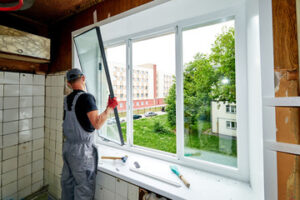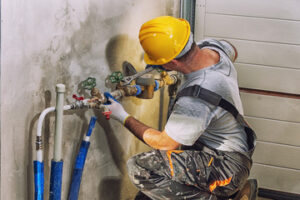Electricians perform the installation, repair, and maintenance of electrical systems in homes, businesses, and other buildings. They use a variety of tools, including a digital multimeter to measure current and voltage.

Math and physics classes are helpful for electricians, as well as strong customer communications skills. They must read blueprints and wiring schematics and be able to decipher colors on wire insulation. Visit Website to learn more.
The network of wires that supply electricity to different parts of a building or machine is known as wiring. The wires may be colored to indicate their purpose, such as black for switches and blue for sockets. These wires should be properly insulated to prevent accidents such as fires. Faulty wiring is the major cause of house fires. The work of an electrician requires a good deal of manual dexterity and problem-solving skills. The career of an electrician is rewarding and offers job security.
Electricians are responsible for installing, repairing, and maintaining electrical systems throughout buildings and commercial facilities. Their duties include working with various technologies such as solar power, renewable energy, and smart grids. They are also required to comply with local and national electrical codes.
Residential Electricians are tasked with the responsibility of installing and repairing the electrical system in homes and small apartment buildings. They also work closely with homeowners to ensure that the installed outlets, circuit breakers, and lighting fixtures meet safety standards. The duties of a Residential Electrician require strong communication skills and the ability to read blueprints and wiring schematics.
In order to perform this work, an electrician must have a variety of tools. This includes a tape measure that is accurate and durable enough to mark the lengths of wires. It is also important to label the cables once they have been threaded through the walls of a room. This can be done with masking tape or by writing directly on the cable itself.
It is also important to choose the right materials for the job. In new construction, the building code requires non-metallic sheathing for any wire that will be routed through a wall. This is commonly referred to as Romex. It is also necessary to make sure that the breaker box has enough capacity for the electrical load.
An electrician’s career can be rewarding and fulfilling, but it also requires a commitment to continual learning. The role is constantly evolving due to changes in technology and the development of new regulations. In addition, the work is often hands-on and does not allow for much opportunity to telecommute.
Installation
Electricalians install and maintain the power, communications, lighting, and control systems that make modern life possible. This can involve rewiring equipment or fixtures, inspecting electrical components to ensure safety and compliance with building codes, and troubleshooting problems with existing systems.
Some electricians work as contractors, managing their own businesses and hiring employees to assist them. Others work as part of a construction team, overseeing the installation of electrical components as part of larger building projects. Still others may specialize in certain types of electrical systems, working with industrial machinery or residential wiring, for example.
All electricians must be able to read and interpret blueprints and other technical documents to understand the electrical schematics they are working with. They must also be able to effectively communicate with their peers and other construction professionals to coordinate efforts and ensure that electrical installations are up to code.
Electricians often work with tools and equipment like screwdrivers, pliers, and conduit benders to complete their daily tasks. They may also need to use test equipment like ammeters and voltmeters to verify the safety and functionality of electrical components and systems.
Every electrical system has its own unique set of challenges, and electricians must be able to think critically about how to approach each project. This can include determining the best location for circuit breakers, analyzing the load capacities of wiring and fixtures, and ensuring that all components are compatible with each other.
Because electricity is a form of energy that produces heat, electricians must be careful not to injure themselves or damage equipment while performing their work. This can include wearing protective gear, following safety protocols when handling electrical components, and minimizing the amount of time spent in confined spaces or at heights.
Maintenance
A maintenance electrician is responsible for the general upkeep of a building’s electrical wiring and appliances. They regularly inspect the premises, repair faulty wiring and replace appliances that are no longer functioning properly. This ensures that the building meets all local safety and fire codes, which is critical to preventing accidents such as electrical fires and electrocutions.
As a maintenance electrician, you’ll work on both residential and commercial buildings. You’ll also be responsible for installing and troubleshooting new electrical systems. In addition, you’ll be on call to respond to emergency repairs, such as power outages and heating interruptions. You’ll be expected to complete all assigned duties in a timely manner and maintain a clean and safe work environment.
You’ll also be responsible for setting out jobs from drawings and specifications and preparing requisitions for installation materials. You’ll be required to provide guidance to apprentice Electricians and Electrician’s Helpers. You’ll also be required to supervise the work of other Mechanical Workers.
Depending on the nature of the job, you may be required to perform your duties both indoors and outdoors. You’ll be expected to wear appropriate personal protective equipment when necessary. You’ll also be expected to be familiar with the National Electrical Code, and you’ll be required to complete all applicable safety training.
A high school diploma or GED certificate is required for this role. You’ll also need to attend a vocational trade school or complete an apprenticeship program to learn the skills needed to become an electrician. After completing your education, you’ll be required to take and pass a background check and drug test before you can begin working.
Whether you’re interested in a career as an electrician or just want to start your own business, becoming a licensed professional is essential. Getting your license will help you make the most of your skills and open up more opportunities to get work in the field. With an ever-growing need for trained professionals, there’s no better time to start your journey as a professional electrician than now.
Troubleshooting
When something goes wrong with the electrical system in your home, it can be scary. The invisible network of wires and complex connections can feel like a labyrinth that is impossible to navigate without professional help. Fortunately, there are some simple techniques and questions that you can ask to find the source of your problem.
The first step in troubleshooting is to understand how the fixture or appliance works normally. This allows you to figure out what part of the circuit isn’t working properly. For example, if an outlet or switch feels hot to the touch or has a burning smell, you can assume that there is a dangerous problem with one of the components in the circuit.
Once you have identified the problematic component, the next step is to isolate it. This requires a thorough understanding of the circuit and the individual parts, as well as a knowledge of safety protocols. It is important to use the proper testing equipment and de-energize circuits before beginning work. You should also document your findings and take notes. This will help you identify recurring issues and improve your troubleshooting skills over time.
If you notice that a specific light or outlet turns on when another switch is turned off, this could be a sign that a circuit is overloaded. It is also a good idea to check the voltage of each component in the circuit and eliminate them as possible causes of the problem.
Another common problem is a power surge or brownout. These can be caused by a number of factors, including overloaded circuits and faulty wiring. It is important to note that both of these problems are dangerous and can lead to fires.
A professional electrician can test for and resolve most of these issues. However, if you do decide to tackle the problem yourself, it’s important to follow safety protocols and wear appropriate gear. It is also helpful to have a checklist to follow. There are many available tools, like Limble maintenance software, that can help you create and store troubleshooting checklists that you can easily access on your mobile device.

